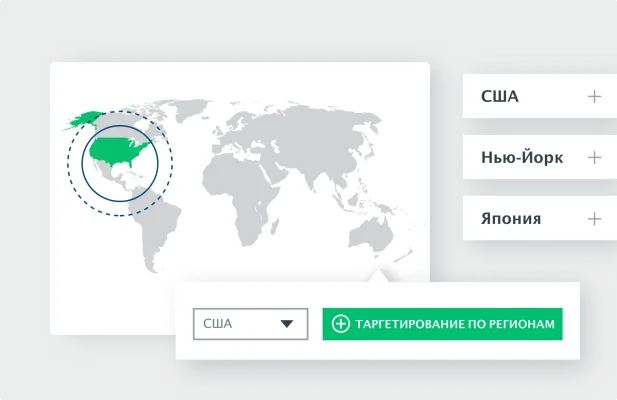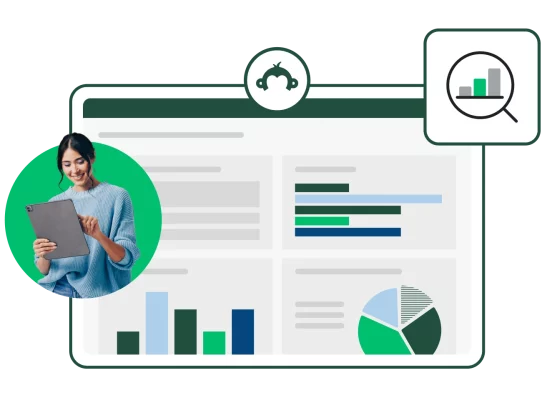Пять типов сегментации рынка и варианты их использования (с примерами)

- Сегментация рынка представляет собой разделение потребительского рынка на отдельные группы на основе общих характеристик.
- Для бизнеса очень важно проводить сегментацию рынка, поскольку это позволяет более эффективно охватывать конкретные группы потребителей, что приводит к повышению уровня удовлетворенности и более высоким показателям в целом.
- Существуют пять типов сегментации рынка: демографический, психографический, поведенческий, географический и фирмографический.
Представьте своих клиентов в виде яркой мозаики, где каждый фрагмент уникален, но при этом они все связаны единым сюжетом. При сегментации рынка как раз таки учитываются эти закономерности для разделения клиентов на группы на основе общих черт, что далее позволяет разрабатывать максимально эффективные стратегии.
Определив сегменты потребителей, компании могут более нацеленно рекламировать свои товары и услуги. У каждого сегмента будут свои предпочтения, определив которые, компании смогут повышать вовлеченность, улучшать взаимодействие и стимулировать продажи.
Что такое сегментация рынка?
Сегментация рынка — это процесс разделения всей совокупности на группы по определенным общим признакам. Такое разделение может быть основано на демографических данных (возраст, пол и т. д.), месте жительства, убеждениях, поведении и сочетании других схожих характеристик.
Разделение общей совокупности на более мелкие группы на основе схожих характеристик позволяет таргетировать рекламу.
Вы можете перечислить характеристики своей целевой аудитории?
Сегментация потребителей с помощью SurveyMonkey поможет их определить за считаные минуты.
Для чего нужна сегментация рынка?
Цель сегментации рынка заключается в создании детальных профилей каждого из сегментов рынка. Имея четкое представление о характеристиках сегментов, маркетологи могут разрабатывать стратегии для сегментов с потенциальными покупателями.
Для этого они используют трехступенчатый процесс, позволяющий лучше узнать потребителей и понять, почему они приобретают те или иные товары.
- Сегментирование: маркетологи разделяют рынок на категории на основе общих черт.
- Таргетирование: они выбирают определенный рынок или целевую аудиторию, которая с большей вероятностью купит их товары.
- Позиционирование: маркетологи проводят исследование с целью определить, какое сочетание продукта, цены, географии и методов продвижения привлечет покупателей.
Определив целевую аудиторию, маркетологам необходимо понять, в чем конкурентное преимущество их продукта. Он лучше, быстрее, дешевле или высокотехнологичнее предложений конкурентов? Чтобы ответить на этот вопрос, маркетологам необходимо понять, с какими проблемами сталкивается их целевая аудитория и каким образом можно их решить.
Конкурентное преимущество создается за счет дифференциации продукта, что позволяет выделиться на фоне конкурентов и стать решением проблем потребителей.
Определив целевой рынок, выявив проблемы, с которыми сталкиваются представители этого рынка, и создав продукт, который решит эти проблемы, маркетологи имеют все шансы обогнать конкурентов.
Примеры сегментации рынка
Сегментация рынка — это первый шаг на пути разработки успешной маркетинговой стратегии. Разделение рынка на сегменты позволяет понять проблемы, с которыми сталкиваются потребители, и придумать для них решение.
Но компании по-разному проводят сегментацию рынка. Существует несколько подходов.
Вот три распространенных примера сегментации рынка.
Отсутствие сегментации
Компании ориентируются на широкую группу потребителей, используя универсальную стратегию. Например, компании, продающие товары широкого потребления, такие как соль, вряд ли будут тратить время и усилия на сегментацию рынка.
Несколько сегментов
Компании могут выявить одну или две узкие целевые группы и занять нишу на рынке специализированных товаров и услуг. В качестве примера таких компаний можно привести бренды одежды высокой моды, товаров ручной работы или бренды, изготовляющие запчасти на заказ.
Тысячи сегментов
Гиперсегментация позволяет персонализировать предложение для каждого клиента и построить долгосрочные отношения. Например: салоны красоты предлагают персонализированные услуги или интернет-магазины, такие как Amazon, предлагают рекомендации на основе вашей истории покупок.
Пять типов сегментации рынка
Для того, чтобы эффективно сегментировать рынок на любое количество групп, важно знать о пяти типах сегментации рынка.
Далее мы разберем каждый из пяти типов сегментации (по демографическим, психографическим, поведенческим, географическим и фирмографическим признакам), а также рассмотрим, как с ними работать.
1. Демографическая сегментация
Демографическая сегментация предполагает, что группа людей с одинаковыми признаками ведет похожий образ жизни, имеет схожие вкусы и интересы, которые, в свою очередь, влияют на их покупательские привычки. Демографические данные часто объединяют с другими видами данных для выявления целевых аудиторий, которые с большей вероятностью будут готовы приобрести ваш продукт.
К демографическим характеристикам относятся возраст, пол, профессия, уровень дохода и образования.
Как использовать данные демографической сегментации
Преимущество демографической сегментации заключается в том, что для нее очень легко собрать данные. Информацию о домохозяйствах, уровне дохода, образования и состояния здоровья, которые можно использовать для разработки маркетинговой стратегии и постановки целей, можно взять из доступных государственных источников, например Бюро трудовой статистики США.
Демографические данные полезны не только для сегментации рынка, но и для сегментации потребителей. С помощью этих данных, а также закономерностей поведения маркетологи могут определить следующее.
- Каков объем рынка, на который компания собирается выходить со своим товаром/услугой?
- Чем компания отличается от конкурентов?
- Люди с какими демографическими характеристиками с большей вероятностью приобретут товары или услуги этой компании?
- Какая рекламная кампания найдет отклик у целевой аудитории?
Сегментация по демографическим данным вместе с данными о покупательском поведении и другими параметрами позволяет составить портрет покупателя и разработать наиболее подходящую маркетинговую стратегию.
2. Психографическая сегментация
Психографическая сегментация позволяет разделить потребителей на группы в зависимости от их образа жизни, черт характера, социального статуса, интересов, мнений и убеждений. Психографические данные — это отличное дополнение к демографическим характеристикам, поскольку они позволяют определить мотивацию, которая заставляет людей принимать определенные решения.
Как давно вы пересматривали демографические данные вашего целевого рынка?
Мир постоянно меняется. Наведите фокус с помощью решения по сегментации потребителей от SurveyMonkey.
Как использовать данные психографической сегментации
Психографическая сегментация — это эффективный инструмент, позволяющий определить проблемы, поведение и отношение клиентов.
Компании используют психографическую информацию при сегментации рынка для того, чтобы разобраться в следующем:
- как потребители воспринимают их товары и услуги;
- чего на самом деле хотят потребители и почему;
- какие недостатки есть у продуктов или услуг компании;
- возможности для повышения вовлеченности;
- как эффективнее взаимодействовать с целевой аудиторией.
3. Поведенческая сегментация
Сегментация рынка по поведенческим признакам — это выявление определенных параметров в поведении идеального покупателя, например что он хочет, почему он этого хочет, какую выгоду он ожидает получить и как он удовлетворяет свои потребности.
Как использовать данные поведенческой сегментации
Поведенческая сегментация работает как для розничных клиентов, так и для корпоративных. Маркетологам проще разработать маркетинговую коммуникацию, когда они понимают, зачем потребители покупают тот или иной продукт. Поведенческие критерии могут быть следующими.
- Причина для совершения покупки. Для покупателей важны выгодная цена, положительные отзывы, безопасность продукта или что-то иное?
- Повод для совершения покупки. Потребителям нужно купить подарок на праздник? Ваши корпоративные клиенты хотят использовать выделенный до конца года бюджет?
- Покупательские выгоды. Покупатель хочет приобрести самую последнюю модель устройства? Или наиболее безопасную модель? Или оказаться одним из первых, у кого есть определенный товар?
- Цикл взаимодействия покупателя с брендом. Покупатель хочет получить дополнительную информацию о продукте, который он, возможно, приобретет? Или он впервые приобретает товар этого бренда?
- Уровень вовлеченности. Покупатель — большой фанат бренда и хочет иметь самую последнюю модель?
Понимая причины, побуждающие потребителей совершать покупки, маркетологи могут разработать более эффективную стратегию сегментации для своих продуктов.
4. Географическая сегментация
Географическая сегментация позволяет маркетологам разделить потребителей на группы по географическим признакам: месту проживания, работы, направлений путешествий.
Местоположение также оказывает большое влияние на покупательские привычки и помогает маркетологам грамотно продвигать продукты. Маркетологи используют различные географические признаки — такие, как например: страна, регион, область, город, район или климатический пояс.
Культурная среда и плотность населения (в городе и за городом) также являются одними из важнейших факторов в исследованиях рынка. Факторы местоположения влияют на проблемы, с которыми сталкиваются жители, что помогает маркетологам придумывать соответствующие решения.

Как использовать данные географической сегментации
От места жительства человека зависит очень многое: от выбора еды до выбора автомобиля. Компании могут использовать географическую сегментацию для определения продуктов, которые будут пользоваться максимальным спросом у конкретной аудитории.
В качестве примера можно привести маркетинговую кампанию по продвижению растений в зависимости от климатического пояса. Герань хорошо растет в жарком климате и любит обилие солнца, в то время как ель лучше приживается в условиях низких температур. Такие детали, связанные с географическим положением, помогают маркетологам определить, какие растения, грунт и сопутствующие товары будут пользоваться большим спросом в разных климатических зонах.
Вот другой пример: магазин одежды может рекомендовать свои пальто потребителям, живущим в местности с более холодным климатом. Адаптация рекомендаций на основе места жительства конкретного потребителя может в корне поменять его отношение к покупке определенного товара.
Статья по теме: Полное руководство по опросам для сегментации
5. Фирмографическая сегментация
Фирмографическая сегментация — это аналог демографической сегментации для корпоративных клиентов. Фирмографические признаки описывают характеристики компании-клиента: отрасль, в которой она работает, количество сотрудников, организационно-правовую форму, размер компании, финансовое положение и другие параметры.
Миллионы людей ежегодно переезжают. Изменился ли географический профиль вашей целевой аудитории? Узнайте с помощью решения по сегментации потребителей от SurveyMonkey.
Как использовать данные фирмографической сегментации
Фирмографические данные позволяют маркетологам определить сильные стороны компаний и то, насколько они попадают под критерии целевой аудитории. Они изучают финансовое положение и возможности роста компаний, чтобы понять, насколько этот сегмент рынка успешен.
Вот несколько примеров фирмографических данных.
- Классификация видов экономической деятельности — доступна в ОКВЭД (Общероссийский классификатор видов экономической деятельности).
- Юридический статус и форма собственности — организационно-правовая форма (например, индивидуальный предприниматель, общество с ограниченной ответственностью, акционерное общество, публичное акционерное общество и т. д.).
- Возраст компании — может говорить о финансовом потенциале компании и ее уровне экспертности.
- Количество сотрудников — указывает на размер компании.
- Адрес — то есть местоположение офисов, заводов или магазинов.
- Покупатели и товары — какие товары производит или продает компания и кто ее целевая аудитория.
- Размер рынка — большой ли рынок и есть ли у компании конкуренты.
Преимущества сегментации рынка

Успешная проверка концепции, запуск товаров, эффективные маркетинговые сообщения, реклама и другие важные маркетинговые мероприятия не обходятся без сегментации рынка.
Компании вкладывают немалые средства в то, чтобы понять, с какими проблемами сталкивается их идеальный клиент и как они могут ему помочь решить эти проблемы за счет своих товаров или услуг. Какую пользу от сегментации рынка получают сами компании?
Более эффективные рекламные кампании
Компании тратят миллиарды долларов на рекламу и продвижение, когда они точно знают, кто их целевая аудитория и в чем она нуждается. Сегодня маркетологам доступен большой объем информации о целевой аудитории, и это помогает им формулировать маркетинговые сообщения для нужной целевой аудитории, в нужное время, на нужные продукты.
Опросы отлично подходят для того, чтобы понять, найдут ли маркетинговые сообщения отклик у целевой аудитории. Сначала маркетологи строят гипотезы, а затем тестируют их на респондентах с помощью опросов, чтобы узнать, как они отреагируют. Результаты опроса помогают маркетологам разрабатывать успешные кампании.
Разработка продуктов, отвечающих ожиданиям клиентов
Компании постоянно генерируют новые идеи, но для них важно понять, решают ли их идеи проблемы, с которыми сталкивается их целевая аудитория. Сегментация рынка позволяет компаниям определить спрос на созданный ими продукт.
Опросы помогают компаниям держать руку на пульсе рынка. Всего лишь за несколько часов компании могут получить следующую информацию:
- решают ли они проблемы целевой аудитории;
- какая из предложенных идей выигрышная;
- правильно ли подобраны функции, упаковка и логотип;
- будут ли потребители покупать товар и какую цену они готовы за него заплатить.
Ответы на эти вопросы, полученные от потенциальных клиентов, помогают компаниям запускать успешные продукты, которые будут пользоваться спросом.
Проанализируйте концепцию продукта с помощью SurveyMonkey, чтобы узнать, каким будет спрос на ваш новый продукт. Вы получите сопоставительный анализ, позволяющий определить свое место среди конкурентов.
Выявление новых тенденций и возможностей
Тенденции постоянно меняются. Социальные сети — это отличный источник информации о покупательском поведении, однако эти данные нельзя использовать, пока они не будут измерены.
Суть сегментации рынка заключается в том, чтобы понять поведенческие привычки целевой аудитории. Новые тенденции возникают постоянно, и задача маркетологов — определить, какие из них станут новыми возможностями, а какие мимолетны.
Маркетологи стараются выявить новые проблемы, возникающие у потребителей, чтобы затем разработать эффективную маркетинговую стратегию и провести проверку концепции. Для определения новых возможностей маркетологам нужно постоянно опрашивать свою целевую аудиторию и узнавать у нее, насколько ее удовлетворяют существующие продукты.
Совместное использование данных с другими подразделениями
В результате сегментации рынка вы получаете целый набор надежных данных о потребителях, который может быть полезен и другим подразделениям в вашей компании. В компаниях, работающих с корпоративными клиентами, отделы маркетинга и продаж часто довольно активно сотрудничают. Причем отдел продаж во многом зависит от отдела маркетинга, который привлекает потенциальных покупателей, что приводит к повышению продаж и дохода компании.
Отдел, занимающийся ценообразованием, также может нуждаться в данных о рынке и конкурентах для установки правильных цен. Сюда также стоит добавить производственный отдел, который вряд ли будет доволен срочным заказом на 100 000 единиц товаров, на которые резко вырос спрос. Зная о покупательских трендах заранее, производственный отдел сможет правильно распределить нагрузку.
Как мы видим, данные сегментации рынка могут быть полезны не только команде маркетинга, но и другим отделам в компании.
Повышение доверия к бренду
Компании не просто продают свои товары, в большинстве случаев они также хотят построить долгосрочные отношения со своими покупателями и завоевать их лояльность. Покупатели доверяют бренду, когда им о нем хорошо известно, когда они любят товары этого бренда и постоянно их покупают.
Сегментация рынка выявляет группы потребителей, готовых приобрести ваши товары более одного раза. Сначала компании создают идентичность своего бренда, которая будет привлекать их целевую аудиторию, а затем они повышают осведомленность о бренде и начинают выстраивать доверительные отношения со своими покупателями. Доверие — это фундамент для создания маркетинговой стратегии, разработки новых продуктов и актуального контента, повышая качество обслуживания клиентов и поддерживая их лояльность бренду.
Сегментация целевого рынка помогает маркетологам понять проблемы потребителей и их поведение. На основе этой информации они выстраивают долгосрочные и доверительные отношения со своей целевой аудиторией, благодаря чему выигрывают все.
Какие у вас отношения с вашей целевой аудиторией?
Узнайте, как бренд может завоевать доверие с помощью трекера бренда от SurveyMonkey.
Проведите сегментацию рынка с помощью SurveyMonkey
Разобравшись в преимуществах сегментации рынка, компании могут создавать вовлекающий уникальный контент, который будет привлекать покупателей. Для создания эффективных маркетинговых материалов и повышения вовлеченности важно правильно сегментировать целевую аудиторию.
Узнайте подробнее о том, как сегментировать данные с помощью SurveyMonkey и создать отдельные группы клиентов для эффективного взаимодействия. Зарегистрируйте учетную запись прямо сейчас, чтобы сразу приступить к сегментации рынка.
Начните исследование рынка
Всемирная панель опросов
Соберите данные, разослав опрос репрезентативной выборке.
Экспертные решения
Тестируйте концепции продукта и креативную часть с помощью автоматических инструментов анализа и отчета.
